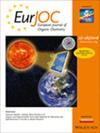三态激发态下亚甲酰亚胺与甲基乙烯酮[3+2]环加成反应的机理:分子电子密度理论研究
IF 2.7
3区 化学
Q2 CHEMISTRY, ORGANIC
引用次数: 0
摘要
本文在分子电子密度理论的框架下,研究了亚甲基亚甲基酰基与甲基乙烯酮在基态和第一三重态激发态下的[3+2]环加成(32CA)反应。基于dft的反应性分析表明,在这两种状态下,亚甲基乙基醚都表现为超亲核试剂,而乙烯基酮则表现为强亲电试剂。32CA反应在基态(3.40 kcal·mol-1)和气相三态(1.47 kcal·mol-1)的活化能都很低。在基态下,32CA反应具有完全的邻位区选择性和完全的内腔立体选择性,而在三重态下,32CA反应具有完全的邻位区选择性和部分的内腔立体选择性。在基态下,反应通过过渡态结构后继续生成螺旋吲哚,而在三重态下,反应停止在双基中间,这需要系统间的交叉才能生成最终的螺旋吲哚。对甲醇中两种状态下32CA反应的动力学参数分析表明,在三重态下,反应速度比基态快589倍。本文章由计算机程序翻译,如有差异,请以英文原文为准。
Mechanistic Insights into the [3+2] Cycloaddition Reaction of Azomethine Ylides with Methyl Vinyl Ketone in the Triplet Excited State: A Molecular Electron Density Theory Study
The [3+2] cycloaddition (32CA) reaction of an azomethine ylide with methyl vinyl ketone in the ground and first triplet excited states has been studied within the framework of molecular electron density theory. A density functional theory‐based reactivity analysis indicates that, while azomethine ylide behaves as a supernucleophile in both states, vinyl ketone acts as a strong electrophile. This 32CA reaction presents a very low activation energy both in the ground state, 3.40 kcal mol−1, and in the triplet state, 1.47 kcal mol−1, in the gas phase. While in the ground state, the 32CA reaction is entirely ortho regio and fully endo stereoselective, in the triplet state it is entirely ortho regioselective but only partially endo stereoselective. In the ground state, the reaction proceeds to form the spirooxindole after passing through the transition state structure, whereas in the triplet state, the reaction stops at a biradical intermediate, which requires an intersystem crossing to yield the final spirooxindole. Analysis of the kinetic parameters of the 32CA reaction in the two states in methanol indicates that in the triplet state, the reaction is only 589 times faster than in the ground state.
求助全文
通过发布文献求助,成功后即可免费获取论文全文。
去求助
来源期刊
CiteScore
5.40
自引率
3.60%
发文量
752
审稿时长
1 months
期刊介绍:
The European Journal of Organic Chemistry (2019 ISI Impact Factor 2.889) publishes Full Papers, Communications, and Minireviews from the entire spectrum of synthetic organic, bioorganic and physical-organic chemistry. It is published on behalf of Chemistry Europe, an association of 16 European chemical societies.
The following journals have been merged to form two leading journals, the European Journal of Organic Chemistry and the European Journal of Inorganic Chemistry:
Liebigs Annalen
Bulletin des Sociétés Chimiques Belges
Bulletin de la Société Chimique de France
Gazzetta Chimica Italiana
Recueil des Travaux Chimiques des Pays-Bas
Anales de Química
Chimika Chronika
Revista Portuguesa de Química
ACH—Models in Chemistry
Polish Journal of Chemistry.

 求助内容:
求助内容: 应助结果提醒方式:
应助结果提醒方式:


